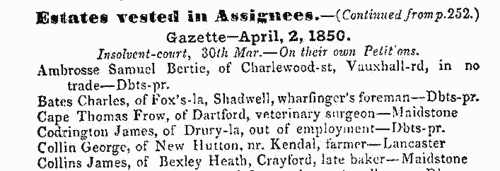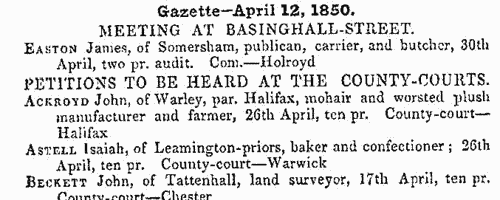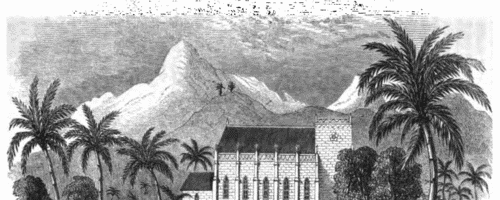Parkyn Surname Ancestry ResultsOur indexes 1000-1999 include entries for the spelling 'parkyn'. In the period you have requested, we have the following 87 records (displaying 31 to 40): Single Surname Subscription | | | Buying all 87 results of this search individually would cost £454.00. But you can have free access to all 87 records for a year, to view, to save and print, for £100. Save £354.00. More... |
These sample scans are from the original record. You will get scans of the full pages or articles where the surname you searched for has been found. Your web browser may prevent the sample windows from opening; in this case please change your browser settings to allow pop-up windows from this site. British Army administration
(1841)
The British Army of queen Victoria's time had a very extensive system of administration. The Royal Kalendar lists officials, both uniformed and civilian, from the Commander-in-Chief's Office at Horse Guards, the Adjutant-General's Office, the Recruiting Department, the Quarter Master-General's Office, the Judge Advocate-General's Office, the Consolidated Board of General Officers, the Cinque Ports, the War Office, the Office of her Majesty's Paymaster-General, the Ordnance Department (including the out-ports and stations at Woolwich, Chatham, Dover, Portsmouth, Devonport, Guernsey, Jersey, Chester and Liverpool, Carlisle, Hull, Landguard Fort and Harwich, Alderne, the gunpowder manufactory at Waltham Abbey, the gunpowder magazines at Hyde Park, Purfleet, Gravesend and Tilbury, Upnor Castle, Priddy's Hard, Tipner Point, Keyham Point, Marchwood and Tynemouth; at Edinburgh, Stirling Castle and Fort George in Scotland; in Antigua, Australia, the Bahamas, Barbadoes, Berbice, Bermuda, Cape of Good Hope, Colombo, Corfu, Demerara, Dominica, Gibraltar, Grenada, Halifax (Nova Scotia), Jamaica, Isle aux Nois, Kingston (Upper Canada), Malta, Mauritius, Montreal, New Brunswick, Prince Edward's Island, Quebec, Rideau Canal, Ottawa Canals, St Christopher, St Helena, St Lucia, St Vincent's, Santa Maura, Sierra Leone, Toronto, Tobago, Trincomalee, Trinidad and Zante), the Royal Military College at Sandhurst, the Royal Hospital at Chelsea, the Royal Military Asylum at Chelsea and Southampton, Army Agents, General Agents for the Recruiting Service, and Army general staff and governors of forts and garrisons in Ireland.PARKYN. Cost: £6.00.  | Sample scan, click to enlarge

|  Persons of standing recommending London police recruits
(1830-1842) Persons of standing recommending London police recruits
(1830-1842)
The Metropolitan Police Register of Joiners (MEPO 333/4) lists policemen joining the force through to 31 December 1842 (to warrant number 19892). The register is alphabetical, in so far as the recruits are listed chronologically grouped under first letter of surname. It is evidently a continuation of a similar earlier register, not closed until its alphabetical sections were filled: consequently, there are no entries in this register for the initial letters N, O, Q, U, V, X, Y or Z; and the sections of this register start at different dates - A 18 April 1840 (warrant number 16894); B 11 December 1830 (5570); C 7 September 1830 (4988); D 27 May 1833 (8445); E 15 December 1838 (14476); F 30 March 1832 (7372); G 1 December 1835 (11,184); H 25 April 1832 (7457); I and J 13 February 1837 (12449); K 2 January 1838 (13457); L 3 October 1834 (9905); M 15 November 1832 (7999); P 4 October 1831 (6869); R 4 September 1837 (13021); S 30 March 1835 (10366); T 6 April 1840 (16829); W 30 December 1833 (9096). The register gives Date of Appointment, Name, Number of Warrant, Cause of Removal from Force (resigned, dismissed, promoted or died), and Date of Removal. Those recruits not formerly in the police, the army, or some government department, were required to provide (normally) at least two letters of recommendation from persons of standing, and details of these are entered on the facing pages: the names in these are indexed here (the police recruits are indexed separately and not included here). Recruits transferred from other forces or rejoining the force did not normally need recommendations - in the latter case, former warrant numbers are given - but some recommendations are from police inspectors, even other constables. Recruits coming from the army sometimes have general military certificates of good conduct, but most often have a letter from their former commanding officer; recruits recommended by government departments (most often the Home Office) similarly have letters from the head of department. But the great majority of the names and addresses in these pages are of respectable citizens having some sort of personal acquaintance with the recruit. Where more than two recommendations were provided, the clerk would only record one or two, with the words 'and others'. Tradesmen are sometimes identified as such by their occupations; there are some gentry. Although the great bulk of these names are from London and the home counties, a scattering are from further afield throughout Britain and Ireland. PARKYN. Cost: £8.00.  | Sample scan, click to enlarge

| Dissolutions of Partnerships
(1843)
Trade partnerships dissolved, or the removal of one partner from a partnership of several traders, in England and Wales
PARKYN. Cost: £6.00.  | Sample scan, click to enlarge

| Dissolutions of partnerships in England and Wales
(1846)
Perry's Bankrupt and Insolvent Gazette, issued monthly, included lists of dissolutions of partnerships gazetted in England and Wales. The names of the partners are given in full, surnames in capitals, followed by trade and address, and date of the end of the partnership. Each entry usually ends with the phrase 'Debts by ...', indicating which partner intended to continue, and resume the responsibilities of, the business. This is the index to the names of the partners, from the issues from January to December 1846.PARKYN. Cost: £6.00.  | Sample scan, click to enlarge

| Deaths, Marriages, News and Promotions
(1847)
Death notices and obituaries, marriage and birth notices, civil and military promotions, clerical preferments and domestic occurrences, as reported in the Gentleman's Magazine. Mostly from England and Wales, but items from Ireland, Scotland and abroad. July to December 1847
PARKYN. Cost: £4.00.  | Sample scan, click to enlarge

| Insolvents imprisoned for debt in England and Wales
(1850)
Perry's Bankrupt and Insolvent Gazette, issued monthly, included brief notices of insolvents' estates surrendered to assignees. Each entry gives the surname and christian name of the insolvent, trade and address, followed by the name of the prison. This is the index to the names of the insolvents, from the issues from January to December 1850.PARKYN. Cost: £6.00.  | Sample scan, click to enlarge

| Insolvents in England and Wales
(1850)
Perry's Bankrupt and Insolvent Gazette, issued monthly, included lists of insolvencies and stages in the process whereby the insolvents petitioned for release from debtors' prison. The insolvent is generally referred to by name (surname first), address and trade. This is the index to the names of the insolvents, from the issues from January to December 1850.PARKYN. Cost: £6.00.  | Sample scan, click to enlarge

| Traders and professionals in London
(1851)
The Post Office London Directory for 1851 includes this 'Commercial and Professional Directory', recording about 80,000 individuals. PARKYN. Cost: £4.00.  | Sample scan, click to enlarge

| Missionary donations from Devon
(1855)
The Congregational and a number of other independent churches together formed the Evangelical Alliance, committed to promoting and supporting missions to the heathen. The areas chosen for their projects were Guiana, South Africa, India, the South Seas and China. The work of the missionaries was not only in preaching the Gospel, but also in translating the Bible into local languages, and establishing churches, schools and orphanages. Orphans and native teachers were often given the names of principal contributors or congregations back in Britain. In Britain the large amounts of money needed for this work were raised among the Congregational and independent congregations, arranged by auxiliaries for each county (although some contributions for each county might in fact come in from congregations and individuals in neighbouring areas); money was gathered by ministers, at special services, by supporters, and in missionary boxes. The accounts of all these contributions were published as part of a monthly magazine called the Evangelical Magazine. Each issue of the magazine carried obituaries of prominent members of the congregations; general articles on religion; reviews of newly-published religious books; home news, mainly about meetings of importance or interest by the alliance or in individual churches; and then a separate section called the Missionary Chronicle. The Missionary Chronicle was devoted to letters and reports from the missionaries; and concludes with a set of accounts of donations towards the missionary work. This is the index to the donations reported in the magazine, January to December 1855, from Devon.PARKYN. Cost: £6.00.  | Sample scan, click to enlarge

|  Sailors and marines on H. M. S. Royal Albert in the Crimean War
(1854-1856) Sailors and marines on H. M. S. Royal Albert in the Crimean War
(1854-1856)
Sebastopol in the Crimea was the great Russian naval arsenal on the Black Sea. A combined assault by British, French and Turkish troops resulted in the reduction of Sebastopol and led to the Treaty of Paris of 27 April 1856, guaranteeing the independence of the Ottoman Empire. By Admiralty Order the Crimea Medal was awarded to sailors and marines present during the campaign, between 17 September 1854 (the first landing at Eupatoria) and 9 September 1855 (when the allies secured Sebastopol). The sailors' medals were mostly delivered to them on board ship in the course of 1856; the marines' medals were sent to their respective headquarters for distribution. The remarks as to distribution in this medal roll therefore give more specific information as to the whereabouts of the sailor recipients in 1856 than about the marines. Her Majesty's Ship Royal Albert, a 120-gun screw steamer, took part in the assault. Four clasps to this medal were awarded to the men present in the actions at Sebastopol itself, Inkerman, Balaklave (Balaclava) and (the sea of) Azoff, but the recipients of these clasps are recorded on separate rolls, not part of this index, but indexed on this site. This index also covers the Royal Albert's two tenders, the Clinker and the Grinder.PARKYN. Cost: £8.00.  | Sample scan, click to enlarge

|
Research your ancestry, family history, genealogy and one-name study by direct access to original records and archives indexed by surname.
|













